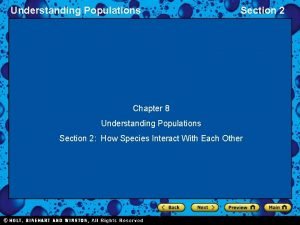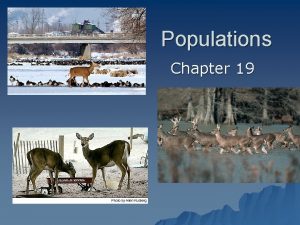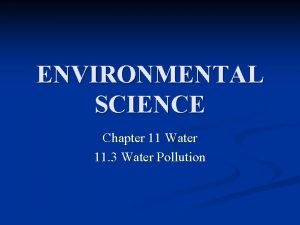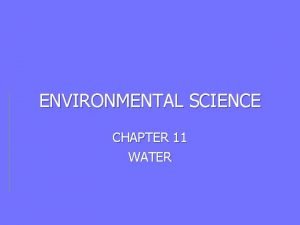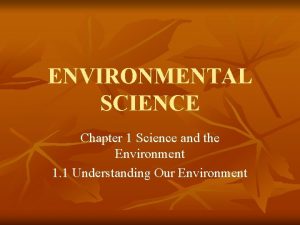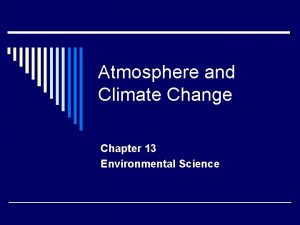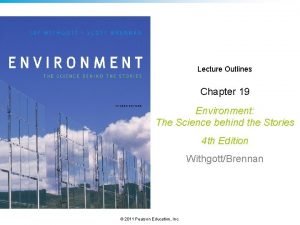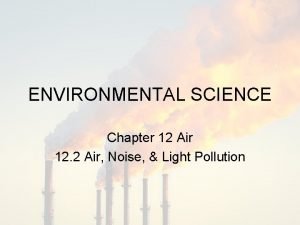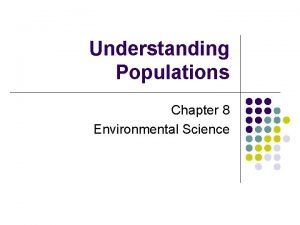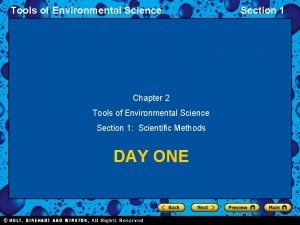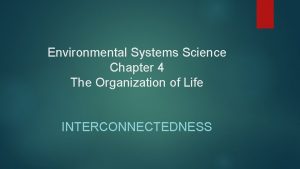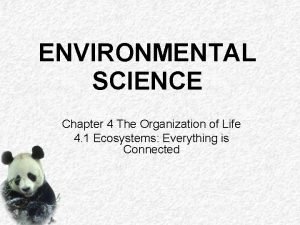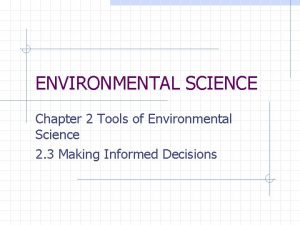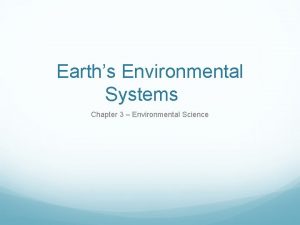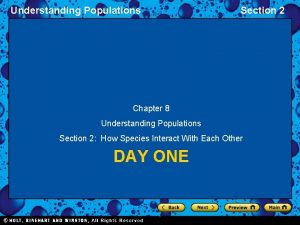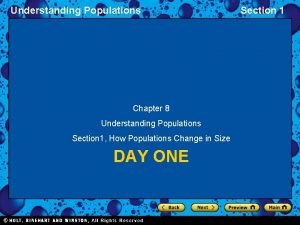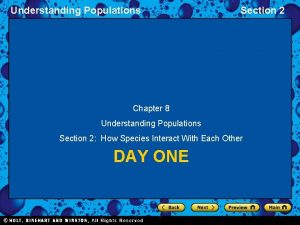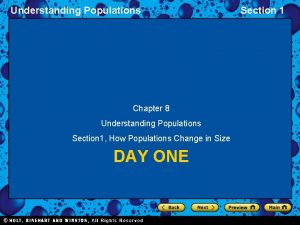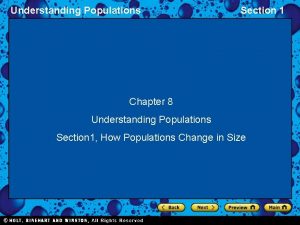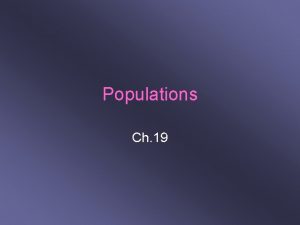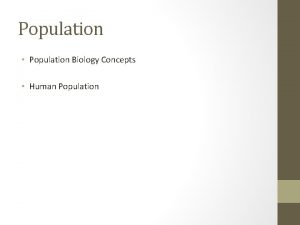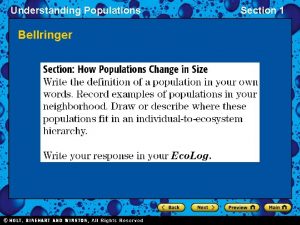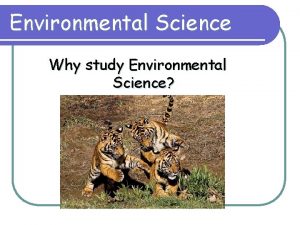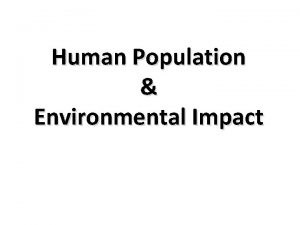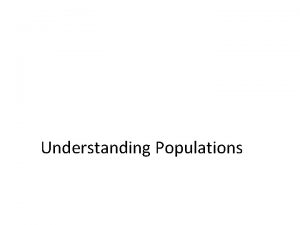Understanding Populations Chapter 8 Environmental Science Population l



















- Slides: 19

Understanding Populations Chapter 8 Environmental Science

Population l l l All the members of a species living in the same place at the same time Organisms from the same population breed with each other, usually not other populations Three ways to describe populations l l Size Density l l Number of individuals per unit area or volume Dispersion l Distribution or arrangement of individuals within a given amount of space

How does a population grow? l Growth rate l Change in the size of a population over a given period of time Change in population size = Birth rate - Death rate

How fast can a population grow? l Reproductive potential l l Maximum number of offspring that each member of a population can produce Some species have a higher reproductive rate than others Biotic potential l Fastest rate that a population can grow Reproductive potential increases when individuals: l Produce more offspring at a time l Reproduce more often l Reproduce earlier in life § Bacteria (short generation time), humans (longer generation time)

Exponential Growth l When a population grows faster and faster l Example: Dog gives birth to 6 puppies § l Next generation – 18 puppies and so on Occurs in nature when: l l Plenty of food and space No competition or predators

What limits population growth? l Carrying capacity l l l The maximum population that the ecosystem can support indefinitely Populations may go over this number Carrying capacity can be estimated, not exact

What limits population growth? l Resource limits l Limiting resource l l A resource that is being consumed at the same rate it is being produced Example: plant growth limited by…. . § § § l Water Sunlight Mineral nutrients Supply of the most limiting resource determines the carrying capacity of an ecosystem

What limits population growth? l Competition within a population l l Species in a population use the same resources in the same ways (ex. Food) Indirect competition l Competing for their territory § l Area defended by one or more individuals against others Territories are valuable to an organism § § Space Shelter Food Breeding sites

Growth Rate l l l Math Practice Page 201 Worksheet

Population Regulation l Density dependent l Deaths occur quickly in crowded populations § § § l Limited resources Predation Disease Density independent l l Portion of population will die regardless of density Possible causes § § Severe weather Natural disasters

Assignment l l l Page 202 Section 1 Review # 2 -5

How Species Interact with Each Other l Niche l l Unique role of a species within an ecosystem Includes: l l Different from habitat l l l Species’ physical home Environmental factors necessary for survival Interactions with other organisms Habitat is only a location Niche is a pattern of how the habitat is used Can be thought of as a job in an ecosystem

Ways Species Interact l Competition l l l Different individuals or populations attempt to use the same limited resource Can occur within a species or between a species Indirect competition l l Example – one insect feeds on a plant during the day and another insect feeds on the same plant at night Adaptations can occur over time to decrease competition § § Using less of a niche than they are capable of using Similar species will divide up the niche to “share space”

Ways Species Interact l Predation l Predator l l Prey l l l Feeds on another organism Organism that is fed upon Organisms can be a predator and the prey Some predators will only eat specific types of prey

Ways Species Interact l Parasitism l Parasite l l Host l l Organism that lives in and feeds on another organism Organism the parasite takes its nourishment from Examples of parasites l l l Ticks Fleas Tapeworms

Ways Species Interact l Mutualism l l l Close relationship between two organisms where both benefit Example – bacteria in your intestines and you Commensalism l l Relationship where one species benefits and the other is neither helped nor harmed Example – Birds nesting in trees (causing no harm to the tree)

Ways Species Interact l Symbiosis l l Relationship where two organisms live in close association Coevolution l l l Relationships may coevolve over time Can reduce the harm to an organism Can increase the benefit to an organism

Assignment l l l Page 209 Section 2 Review # 1 -5

Chapter 8 Review Questions l l Pages 211 -213 # 5 -18, 21 -23, 25, 31
 Chapter 8 understanding populations
Chapter 8 understanding populations Section 19-2 review measuring populations
Section 19-2 review measuring populations Chapter 4 population ecology answer key
Chapter 4 population ecology answer key Chapter 4 section 1 population dynamics study guide
Chapter 4 section 1 population dynamics study guide Tragedy of the commons
Tragedy of the commons Ann arbor mi population pyramid
Ann arbor mi population pyramid My favourite subject is music
My favourite subject is music Objectives of water pollution
Objectives of water pollution Environmental science chapter 11
Environmental science chapter 11 Chapter 1 environmental science
Chapter 1 environmental science Chapter 13 review environmental science
Chapter 13 review environmental science Chapter 19 environmental science
Chapter 19 environmental science Chapter 2 economics and environmental policy
Chapter 2 economics and environmental policy Radonrid
Radonrid Environmental science chapter 8 review answer key
Environmental science chapter 8 review answer key Environmental science chapter 2 review answers
Environmental science chapter 2 review answers The day they parachuted cats into borneo food web
The day they parachuted cats into borneo food web Environmental science chapter 4 the organization of life
Environmental science chapter 4 the organization of life Chapter 2 assessment environmental science
Chapter 2 assessment environmental science Earth's environmental systems chapter 3
Earth's environmental systems chapter 3
